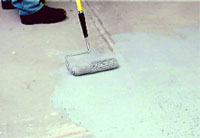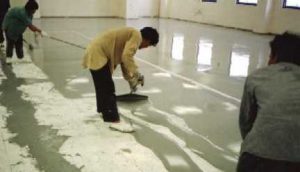Paint
Property
Finishes
Gloss/ Sheen/ Matt/ Semi-gloss/ Vinyl silk/ Textured.
Constituents and Admixtures [2, 4, 5, 7]
Binder/ Vehicle / Medium / Film former (known as resin component)
The purpose is to solidify liquid coating into dry film, to blind the pigment particles, to provide gloss to the coating, to give elasticity, to provide water, chemical and abrasion resistant, to hold the pigment in suspension.
Solvent / Thinner
(e.g: alcohol, hydrocarbon, etc)
Makes the coating liquid enough to be easily and evenly applied by any method. It evaporates completely once the coating has been applied.
Pigment
(e.g: Titanium Dioxide, Calcium Carbonate, Talc Pigments, etc)
Besides providing colour, pigments act as surface protector and to provide opacity or covering paver. To provide opacity or covering power. To aid the film-former in protecting the surface.
Drier, hardener, or catalyst
The main purpose is to speed up drying process, which includes converting the liquid coating into solid state. It helps epoxy and polyurethane resins into hard films.
Plasticiser
To prevent the film of some coatings being too brittle.
Stabiliser
Required by some coatings to ensure that the complex film-former remains intact.
Anti-skinning agent
Added to some oil-based paints to prevent skinning in the tin.
Extender
It provides ease of paint, provide a key in undercoat films for finishing paints to grip and to lower the cost by adding bulk to the paint system.
Thixotropic agent
Gives a jelly-like structure to paints, provides anti-sag and high build properties.
Colors
Colors come from either organic or inorganic pigments.


Solvents for the Paints
Water based/ Solvent based.
Resin Component
The selection is based on the type of substrate.
I.e. Epoxy, Alkyd, Acrylic, Polyurethane, Fluorocarbon, Silicone, etc.
Painting System [1]
sources from: Nippon Paint Pte Ltd, BCA; Good Practice Guide.
Primer
Used for wood and metal substrate. The function of the primer is to grip the substrate, to provide protection against corrosion/ dampness, and to provide a good key for remaining coats.
Sealer
Used for cement based substrate. To resist alkali attack from cement based material, to improve adhesion, to seal problematic surfaces (e.g. resinous wood), to stabilize loose surface particles, and to reduce porosity of receiving substrate as to prevent undue absorption of resin from subsequent coats of paints.
Undercoat
To provide opacity thus contains large quantities of pigments, to level out minor irregularities, provides uniform texture, and to improve inter-coating adhesion.
Topcoat/ finishing coat
To provide durable layer (protect against UV rays, humidity, chemical, corrosion, algae, abrasion, etc), decorative purposes (color, texture, gloss level), and to provide special requirement includes fire resistant, anti-condensation, etc.
Texture
To give 3D esthetical appearance and decorative purposes.
![]()
![]()
![]()
![]()
Drying Time
Touch dry / Hard dry (e.g. 15 min-7 hr)
Resistance
Ultra-violet/ Chemical/ Abrasion/ Fungus/ Algae/ Dirt/ Bacteria/ Alkali/ Wet scrub
Outdoor Durability
Gloss retention/ Colour fastness/ Ultra-violet
Storage Stability
Settling tendency/ Viscosity stability
Thermal Conductivity
± 0.23 W/m K [7]
Water Vapour Transmission
100-200 g/m² . 24 hrs
Water Absorption
± 0.12 kg/m².h 0.5
Density
± 1.4-1.50 g/ cm³
100% Solid Polymer-based Coating
Solvent free. Usually used as basement carpark/ warehouse floor finishes.


Recommended application:
| Human traffic | water based epoxy coating |
| Light to heavy traffic (internal) | 100% solid epoxy |
| Exposed to weathering | 100% solid PU |
Source: Nippon Paint Pte Ltd
Addition of aggregate is prefered to achieve the anti slip performance.
Thickness
Recommended application for basement flooring: 20 micron (8 mil) wet/ dry
Physical Properties
| Abrasion resistance | ASTM D4060 | 70 mgm per 1000 cycles |
| Impact resistance | ASTM D2974 | 3.95 J (35 in/ lbs) |
| Adhesion | ASTM D4541 | 35 kg/cm² (500 psi) |
| Scratch resistance | BS 3900 Part E2 | No failure at 2.5 kg load |
Courtesy of Nippon Paint Pte Ltd